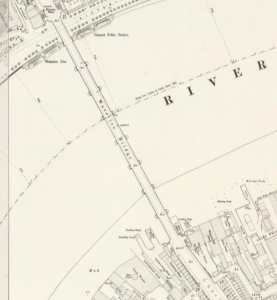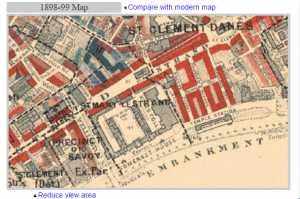This is the location of the Waterloo Bridge in London. Within this area it is common to have small thefts such as animal thefts, pick pocketing, small grand larceny and many more. Not only is it a source of crimes but it is a site of factories. To add to that the location around the Waterloo Bridge was generally middle class with glimpses of fairly comfortable households (earning wise).

When it comes to the crimes in London specifically on or right next the Waterloo Bridge there are a few examples of pick pockets as well as the strange animal theft. It was a case of a man named Thomas Jones in 1694 stole 7 tamed pigeons, why you might ask, the source has no reason to the act only the report of what happened.
“1694. THOMAS JONES was indicted for stealing, on the 19th of July , 7 live tame pigeons, price 5s. , the property of John Simmons Winterflood and John Brown .
ROBERT DUKE . I am an officer. On the 19th of July I searched the prisoner’s room in Steward’s-rents, Drury-lane, and found seven live pigeons; the prosecutor claimed them.
JOHN SIMMONS WINTERFLOOD. I know the pigeons – they were the joint property of myself and John Brown; I had seen them the day before on our coal-wharf, at Waterloo-bridge – the prisoner was in our employ – I would take him back again.
GUILTY . Aged 21.
Fined One Shilling and Discharged .(Old Bailey)
Now when it comes to the factory business around the bridge it was mostly local, for example there was a factory built shortly after the water-works were opened, “…a large shot factory was built close by, together with a fine wet-dock for the loading and warehousing of goods.” (British-history.ac.uk) since they were built near each other it helped the production, export and import rate. Later on they would open another shot manufacturer by Messrs Watts in the year 1789. This factory stood over 140 feet tall and is shown in the picture below.
Finally the levels of poverty in the area. According to the Charles Booth Archive map, it is shown that the poverty level around the Waterloo Bridge was relatively middle class with glimpses of Comfortable living households. This could be a reason for the pick pocketing crimes, due to the higher wealth the more poor people would come to this bridge (due to it location and how there were always people on it).
The way the Waterloo Bridge relates to the Sherlock Holmes story, The Man with the Twisted Lip; is that within the story at one instance it describes the location of the bridge and how it is used among the citizens surrounding it;
“In town the earliest risers were just beginning to look sleepily from their windows as we drove through the streets of the Surrey side. Passing down the Waterloo Bridge Road we crossed over the river, and dashing up Wellington Street wheeled sharply to the right and found ourselves in Bow Street. Sherlock Holmes was well known to the force, and the two constables at the door saluted him. One of them held the horse’s head while the other led us in.” (Eastoftheweb.com)
It describes it as a place at which in one point of the day everyone would have crossed it.
References
Booth.lse.ac.uk,. ‘Booth Poverty Map (Charles Booth Online Archive)’. N.p., 2015. Web. 9 Nov. 2015.
British-history.ac.uk,. ‘Lambeth: Waterloo Road | British History Online’. N.p., 2015. Web. 9 Nov. 2015.
Eastoftheweb.com,. ‘Short Stories: The Man With The Twisted Lip By Arthur Conan Doyle’. N.p., 2015. Web. 9 Nov. 2015.
Oldbaileyonline.org,. ‘Results – Central Criminal Court’. N.p., 2015. Web. 9 Nov. 2015.


